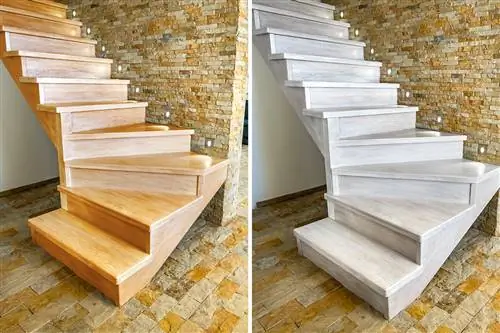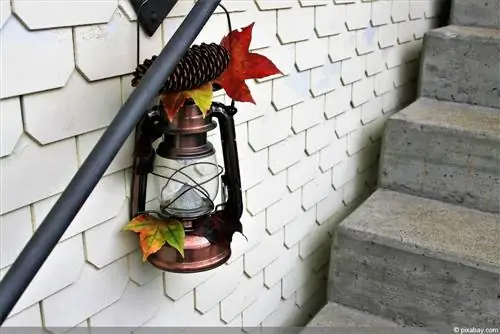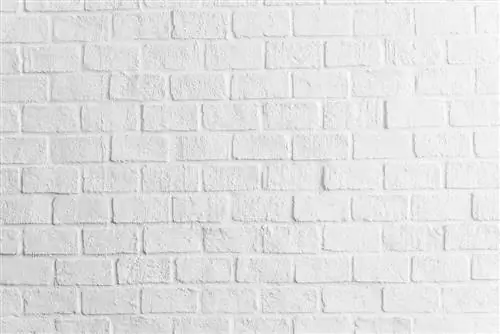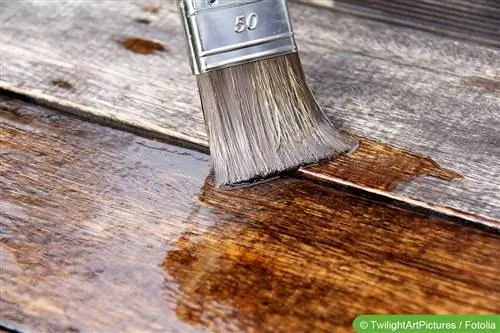- Author admin [email protected].
- Public 2023-12-17 03:39.
- Last modified 2025-06-01 06:48.
Staining, varnishing or painting - whitening a wooden staircase is actually easy. But which means should you choose? We help with useful information.
Wood Color
White wood paint is available in a variety of price ranges, can be chosen for indoor or outdoor use and usually has high coverage. Apart from these advantages, the wood color also has other advantages. Below:
- easy application possible
- long shelf life
- Flaws are safely covered
A potential disadvantage, however, is that in addition to color errors or other color differences, the grain is also completely covered up. This is an advantage for older wood or a type of wood with an inconspicuous grain. However, if you want to preserve the natural pattern, wood color is not the right choice. In addition, depending on the color variant, two coats should be applied. In some cases, only then can complete coverage and an even result be achieved.
Tip:
Sanding the wood is recommended before painting. This allows the color to be absorbed and absorbed more evenly.
Paint
Varnish, like paint, has advantages and disadvantages. The benefits are:
- variable opacity
- long shelf life
- easy cleaning after drying
- appealing shine or subtle, matt surface
However, painting a wooden staircase is comparatively complex. The following steps are necessary:
- As with painting with wood paint, the stairs should first be sanded and cleaned thoroughly. Remains of paint, varnish or other materials must be removed without leaving any residue. Just like dust and other contamination, they could have a negative impact on the result.
- When the stairs are clean and dry, a primer is first applied. This must be coordinated with the following paint. When it comes to drying time, the manufacturer's instructions must be taken into account.
- Once the primer has been applied and completely dried, painting can begin. A foam roller can be used for the larger surfaces of the steps. Edges and corners are better painted with a brush.
- Finally, a sealant is applied. This extends the durability of the paint and allows it to remain attractive for a long time. This protective measure is particularly recommended for heavily used wooden stairs.
The drying time varies depending on the respective product.

Tip:
If several layers of varnish are necessary, they should be allowed to dry sufficiently. On the other hand, the layers should be roughened using a sander and fine sandpaper. This achieves stronger adhesion.
Lasur
Lasur, in contrast to paint and varnish, should preferably be used indoors. However, with appropriate sealing, it can also be used outdoors. The advantage of glazing is that:
- the wooden surface remains matt
- the grain continues to shine through
- it's easy to apply
- variable results can be achieved by order
The disadvantage of glazes as wood protection, however, is that they are less resistant. Varnishes and paints are therefore the better choice for heavily used stairs. With a seal, a glaze can also last a long time. The decisive and unique selling point is that the grain of the wood is still visible. Even when applying two coats, the natural pattern can be seen, but it is whitened.
The procedure is as follows:
- Clean the wood and remove any remaining varnish, paint or oil.
- Slightly roughen the surface with a sander so that the glaze can absorb better.
- Treat the steps with a paint roller and the selected glaze.
- After it has soaked in and dried, you can decide whether a second coat is desired. This makes the grain less noticeable and the white covers more.
- When the desired effect has been achieved, a sealant can be applied. It is also possible to use clear varnish for this. Depending on personal taste, this can be matte or shiny. In any case, it extends the service life, increases resilience and makes cleaning easier.






